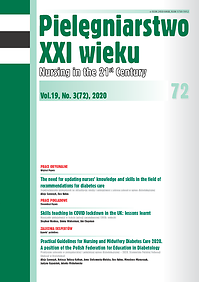Skills teaching in COVID lockdown in the UK: lessons learnt
DOI:
https://doi.org/10.2478/pielxxiw-2020-0018Keywords:
COVID 19, pandemic, clinical skills, lockdown, learning onlineAbstract
SKILLS TEACHING IN COVID LOCKDOWN IN THE UK: LESSONS LEARNT
Introduction. Social distancing is one of the community mitigation measures that has been recommended during the COVID 19 pandemic. Social distancing can reduce virus transmission by increasing physical distance or reducing frequency of meeting in socially dense community settings, such as Universities or workplaces. In response to this, Birmingham City University School of Nursing and Midwifery rapidly developed and transferred much of their student learning online. However, for healthcare students this is not always practicable and is particularly notable in respect to developing clinical skills which cannot be learnt online nor should be attempted for the first time in practice. Birmingham City University has recently actively sought to address such training needs. In April, it opened its campus as a Skills Training Hub to help upskill hundreds of students taking on extended work placement in a bid to bolster frontline NHS workforce numbers to aid in the fight against COVID 19. When opening Birmingham City University Skills Hub, the primary focus of the planning phase was towards promoting staff and student safety.
Conclusions. The plans that were put in to place meant that clinical skills teaching had to be organised diff erently from how it was before lockdown and in a way that was safe and sustainable for future needs.
References
1. Dept of Health and Social Care. Coronavirus action plan: a guide to what you can expect across the UK. Crown Copyright; 2020. [online] ttps://www.gov.uk/government/publications/coronavirus-action-plan/coronavirus-action-plan-aguide-to-what-you-can-expect-across-the-uk
2. Health and Safety Executive. Talking with your workers about preventing coronavirus. Crown Copyright; 2020. [online] http://www.hull.gov.uk/sites/hull/files/media/HSE_-_Talking_wit.pdf
3. Nursing and Midwifery Council. Future Nurse: Standards of profi ciency for registered nurses. NMC; 2018.
Downloads
Published
Issue
Section
License
Copyright (c) 2020 Authors

This work is licensed under a Creative Commons Attribution-NonCommercial-NoDerivatives 3.0 Unported License.




